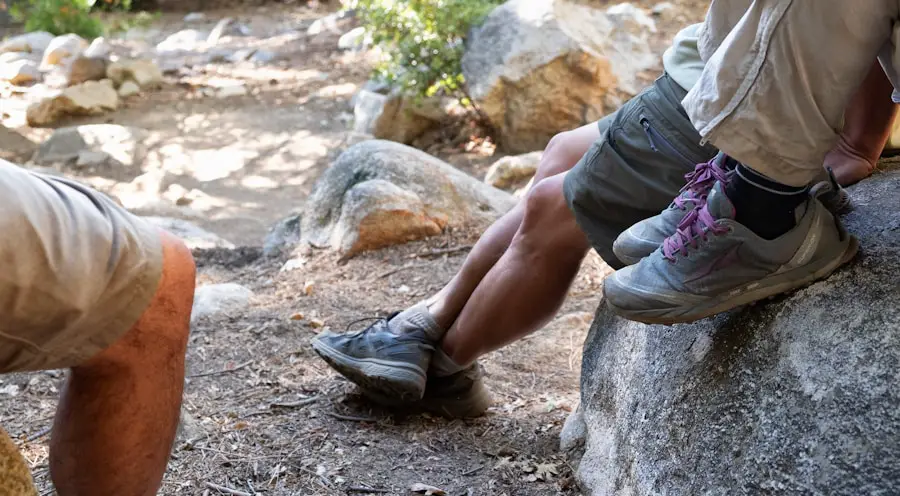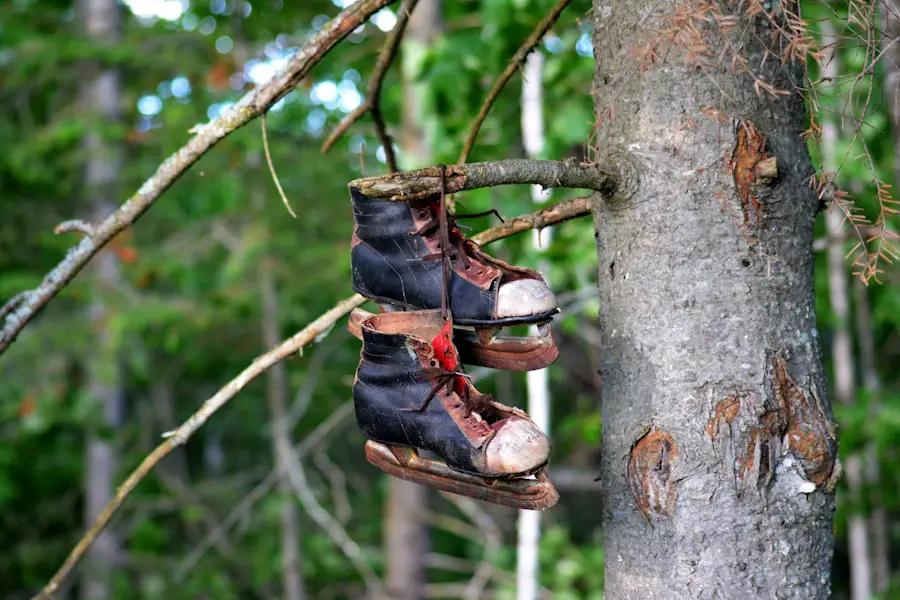Breaking in hiking boots is a crucial step that can significantly enhance the overall hiking experience. New boots, while often designed with comfort and support in mind, can still present challenges if worn without proper acclimatization. The process of breaking in allows the materials to soften and conform to the unique shape of the wearer’s feet, reducing the likelihood of blisters and discomfort during long treks.
This is particularly important for hiking enthusiasts who may spend hours traversing rugged terrains, where even minor discomfort can escalate into a major issue. Moreover, breaking in hiking boots helps to ensure that the footwear provides adequate support and stability. Hiking boots are engineered to protect the feet from uneven surfaces, sharp rocks, and other potential hazards.
However, if the boots are not properly broken in, they may not offer the necessary support, leading to fatigue or even injury. A well-broken-in pair of boots will allow for better foot movement and flexibility, which is essential for navigating challenging trails. Therefore, investing time in the break-in process is not just about comfort; it is also about safety and performance on the trail.
Key Takeaways
- Breaking in hiking boots is important to prevent blisters and discomfort on the trail
- Choose hiking boots that fit well and provide proper support for your feet and ankles
- Gradually break in your hiking boots by wearing them for short periods of time before longer hikes
- Wear your hiking boots around the house to help them mold to your feet
- Test your hiking boots on short hikes to ensure they are comfortable and supportive
- Use high-quality socks and insoles to improve comfort and support in your hiking boots
- Address any discomfort or hot spots by adjusting lacing and using moleskin or blister pads
- Regularly clean and condition your hiking boots to prolong their lifespan and maintain their performance
Choosing the Right Hiking Boots
Consider Your Hiking Plans
When choosing hiking boots, consider factors such as the type, climate, and personal foot shape. For instance, a multi-day backpacking trip through rugged mountains requires a sturdy boot with ankle support and waterproof features. Conversely, casual day hikes on well-maintained trails may suffice with a lighter boot or trail runner.
Fit is Critical
A proper fit means enough room in the box to wiggle your toes while ensuring a snug heel to prevent slippage. Many brands offer different widths and sizes, so try on several pairs to find the best match for your foot shape. Additionally, consider the type of socks you’ll wear during hikes; thicker socks may require a slightly larger boot size.
Try Before You Buy
It’s beneficial to try on boots later in the day when your feet are slightly swollen from daily activities, giving you a more accurate sense of how they’ll feel during extended wear.
Gradual Break-in Process

The break-in process for hiking boots should be approached gradually to ensure maximum comfort and effectiveness. Rushing this process can lead to painful blisters and sore feet, which can deter even the most enthusiastic hiker from enjoying their time outdoors. A gradual break-in allows the materials of the boot—such as leather or synthetic fabrics—to adapt to the contours of your feet without causing undue stress.
This process typically involves wearing the boots for short periods before embarking on longer hikes. Initially, it is advisable to wear your new boots for short durations during everyday activities. This could include wearing them while running errands or during casual walks around your neighborhood.
The goal is to allow your feet to adjust to the new footwear while also giving the boots a chance to flex and mold to your foot shape. As you become more comfortable with the fit, you can gradually increase the duration and intensity of wear, eventually transitioning to longer walks or hikes on flat terrain before tackling more challenging trails.
Wear Them Around the House
| Activity | Time Spent |
|---|---|
| Walking around the house | 1 hour |
| Standing while cooking or doing dishes | 30 minutes |
| Doing household chores | 45 minutes |
| Relaxing on the couch | 2 hours |
One of the simplest yet effective ways to break in hiking boots is by wearing them around the house. This method allows you to acclimate your feet to the new footwear in a controlled environment where you can easily monitor any discomfort or pressure points. Start by wearing your boots for short periods while doing household chores or relaxing in your living room.
This not only helps in softening the materials but also allows you to assess how well they fit during various activities. While wearing them at home, pay attention to any areas that may feel tight or cause irritation. If you notice any discomfort, consider adjusting your lacing technique or trying different sock combinations.
For instance, if the boots feel too tight around the arch or instep, loosening the laces in those areas can provide relief. Additionally, this practice allows you to become accustomed to the weight and feel of the boots without the pressure of being on a trail, making it an ideal first step in the break-in process.
Short Hikes for Testing
Once you have worn your hiking boots around the house and feel comfortable with them, it’s time to take them on short hikes for testing purposes. These initial outings should be on easy trails that are not too demanding, allowing you to focus on how well your boots perform under real hiking conditions without overwhelming your feet. Short hikes serve as an excellent opportunity to evaluate not only comfort but also traction and support on varied surfaces.
During these test hikes, pay close attention to how your feet feel throughout the journey. Are there any hot spots developing? Do you feel adequate support from the boot?
If you experience discomfort, it’s essential to address it immediately rather than waiting until you’re on a longer trek.
This might involve adjusting your laces for a better fit or even considering different insoles for added comfort. The goal is to identify any issues early on so that you can make necessary adjustments before embarking on more strenuous hikes.Use Socks and Insoles

Choosing the Right Socks
When selecting socks for hiking, it’s essential to opt for materials that wick moisture away from your skin while providing cushioning and support. Merino wool is a popular choice due to its natural moisture-wicking properties and ability to regulate temperature, keeping your feet warm in cold conditions and cool when it’s hot outside.
Thicker Socks for the Break-in Period
Additionally, consider using thicker socks during the break-in phase as they can help fill any gaps in fit and provide extra cushioning. This can make a significant difference in the comfort level of your hiking boots during the initial break-in period.
Insoles for Enhanced Comfort and Support
Insoles are another critical component that can enhance comfort and support within your hiking boots. Many hiking boots come with standard insoles that may not provide adequate arch support or cushioning for every foot type. Custom or aftermarket insoles can be tailored to your specific foot shape and needs, offering better alignment and reducing fatigue during long hikes. When trying out new insoles, ensure they fit well within your boots without causing any additional pressure points or discomfort.
Dealing with Discomfort
Experiencing discomfort during the break-in process is not uncommon; however, knowing how to address it effectively can make all the difference in ensuring a positive hiking experience. If you start feeling hot spots or blisters forming on your feet, it’s crucial to take immediate action. One effective strategy is to stop and remove your boots periodically during hikes to allow your feet some relief and assess any problem areas.
Applying blister prevention products such as moleskin or blister pads can also provide an extra layer of protection against friction. Another approach is to adjust your lacing technique based on where you feel discomfort. For example, if you notice pressure on your toes, loosening the laces near the toe box can create more space and alleviate pressure.
Conversely, if your heel is slipping out of the boot, tightening the laces around the ankle can help secure your foot better within the boot’s confines. It’s essential to listen to your body; if discomfort persists despite adjustments, it may be worth considering whether you need a different size or style of boot altogether.
Maintenance and Care for Hiking Boots
Proper maintenance and care for hiking boots are vital for prolonging their lifespan and ensuring optimal performance on trails. After each hike, it’s essential to clean your boots thoroughly to remove dirt, mud, and debris that can accumulate during outdoor adventures. Use a soft brush or cloth along with mild soap and water to clean both the exterior and interior of the boots.
For leather boots, applying a specialized leather conditioner after cleaning can help maintain suppleness and prevent cracking. Additionally, storing your hiking boots correctly is crucial for maintaining their shape and integrity. Avoid leaving them in direct sunlight or damp areas; instead, store them in a cool, dry place away from heat sources.
If possible, use boot trees or stuff them with newspaper to help retain their shape when not in use. Regularly checking for signs of wear—such as frayed laces or worn-out soles—can also help catch potential issues before they become significant problems that could affect future hikes. By investing time in maintenance and care, hikers can ensure their boots remain reliable companions on countless adventures ahead.
If you’re looking to break in your hiking boots before hitting the trails, you may also want to check out this article on the best compact binoculars for hiking here. Having the right gear and equipment can make all the difference in your outdoor adventures.
Love travel? Join Our Facebook Community
FAQs
What are the benefits of breaking in hiking boots?
Breaking in hiking boots helps to soften the materials, mold them to the shape of your feet, and reduce the risk of blisters and discomfort during long hikes.
How long does it take to break in hiking boots?
The time it takes to break in hiking boots can vary depending on the materials and your individual feet. It can take anywhere from a few days to a few weeks of regular wear.
What are some tips for breaking in hiking boots?
Some tips for breaking in hiking boots include wearing them around the house, gradually increasing the duration of wear, using thick hiking socks, and applying leather conditioner to soften the material.
Can I speed up the process of breaking in hiking boots?
While it’s important to allow for natural wear and tear to break in hiking boots, you can speed up the process by flexing the boots, using a boot stretcher, and applying leather softening products.
How do I know if my hiking boots are properly broken in?
You will know your hiking boots are properly broken in when they feel comfortable, no longer cause blisters or hot spots, and provide good support and stability during hikes.
